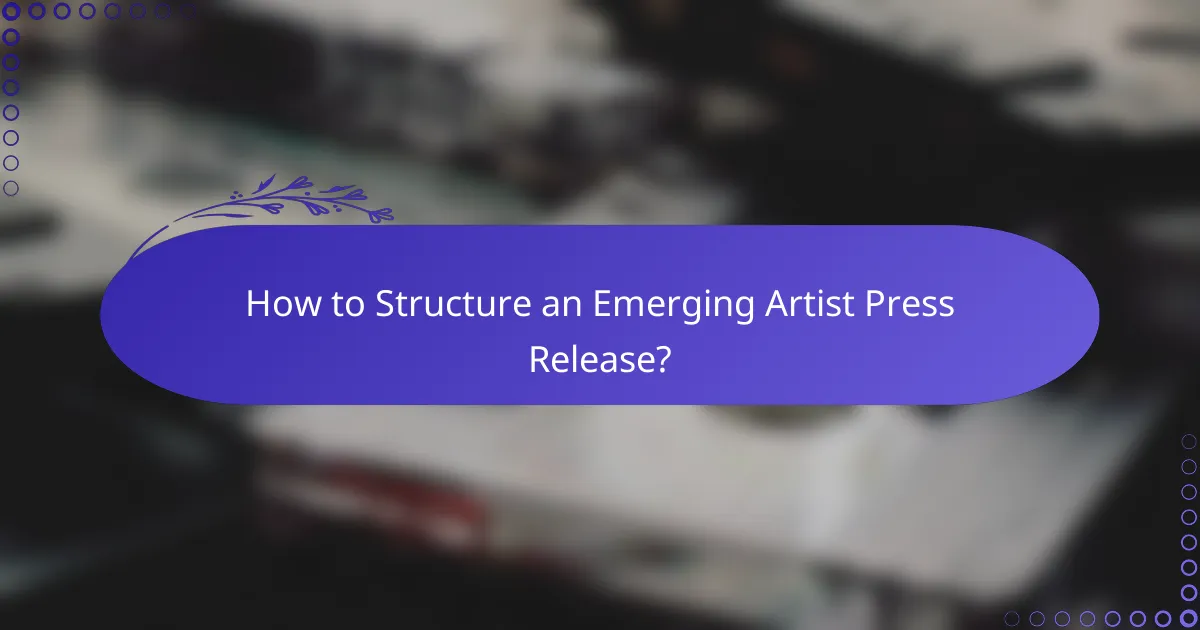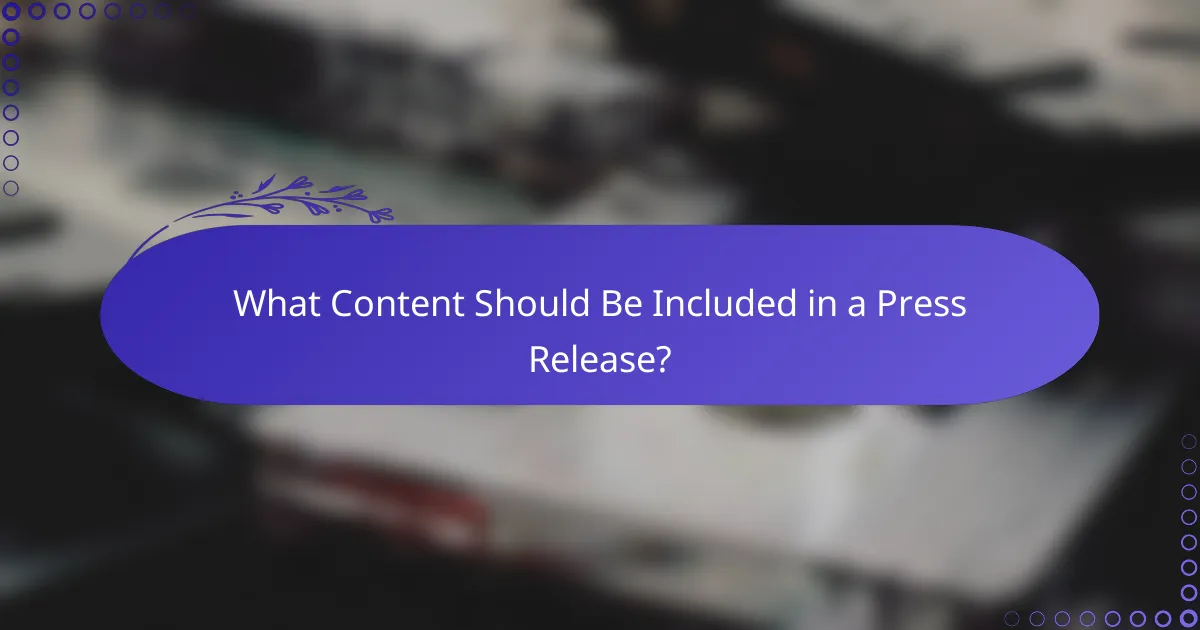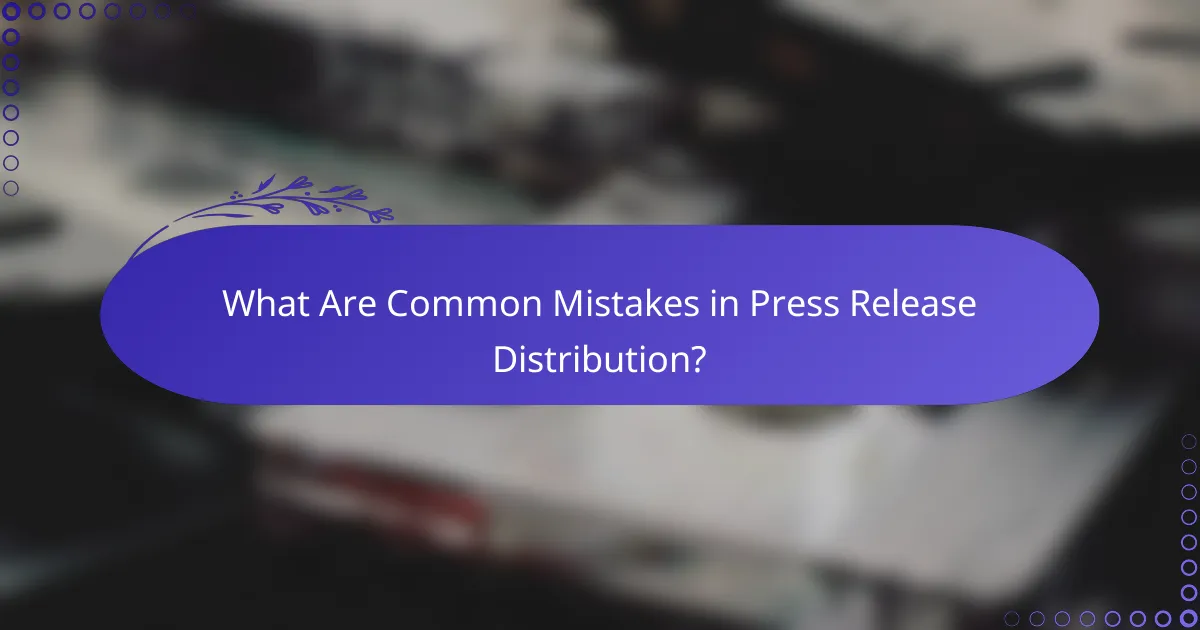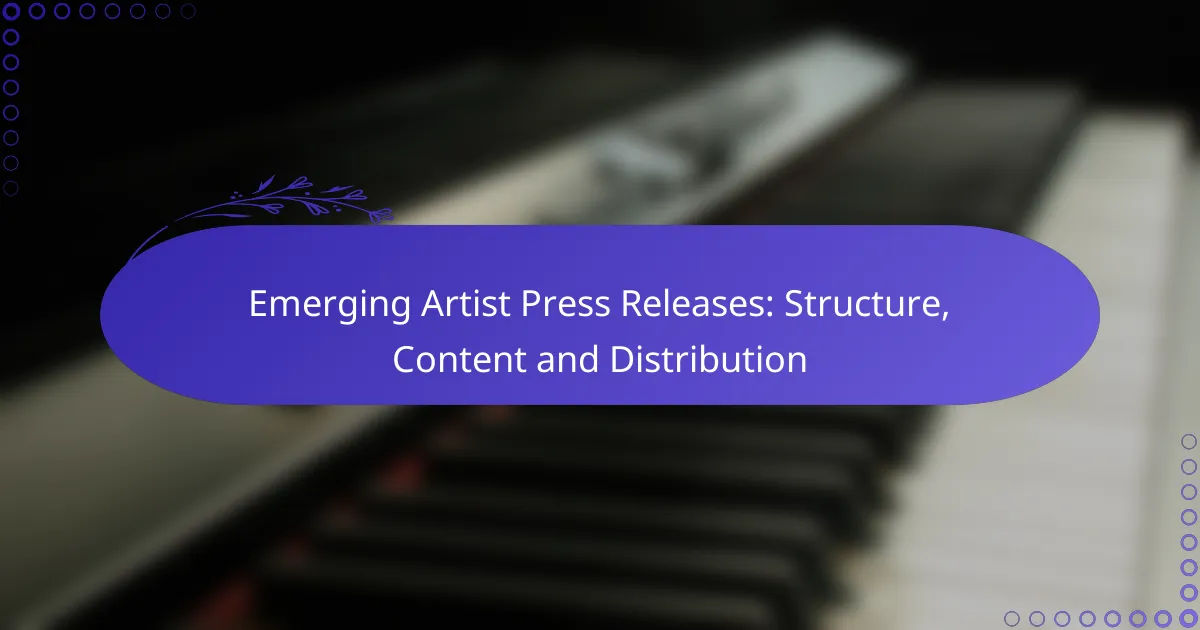Crafting a press release for an emerging artist requires a clear structure that captures attention while conveying vital information. By including key details about the artist’s background, upcoming events, and media assets, the release can effectively engage journalists and media outlets. Additionally, strategic distribution through online platforms, social media, and music publications is essential for maximizing visibility and audience engagement.

How to Structure an Emerging Artist Press Release?
Structuring an emerging artist press release involves creating a clear and engaging format that captures attention and conveys essential information effectively. A well-organized press release can significantly enhance visibility and interest in the artist’s work.
Headline and Subheadline
The headline should be catchy and concise, summarizing the main news in a way that grabs attention. Use strong action verbs and relevant keywords to ensure it resonates with the target audience.
The subheadline can provide additional context or a secondary angle, elaborating on the headline’s promise. This combination sets the tone and encourages further reading.
Body Paragraphs
The body paragraphs should provide detailed information about the artist, their work, and the purpose of the press release. Start with the most important details, such as the release of a new album or upcoming performance, followed by background information about the artist’s journey and achievements.
Use clear and engaging language, breaking up text into short paragraphs for readability. Including quotes from the artist or collaborators can add a personal touch and enhance the narrative.
Contact Information
Always include contact information at the end of the press release to facilitate media inquiries. This should consist of the artist’s management or publicist’s name, phone number, and email address.
Providing links to the artist’s website and social media profiles can also help journalists access additional information and visuals, making it easier for them to cover the story.
Call to Action
A strong call to action encourages readers to engage further with the artist’s work. This could be an invitation to listen to a new single, attend a concert, or visit the artist’s website for more information.
Make the call to action clear and compelling, using phrases like “Listen now,” “Get tickets,” or “Follow for updates” to prompt immediate responses from the audience.

What Content Should Be Included in a Press Release?
A press release for an emerging artist should include essential information that highlights their background, upcoming events, and media assets. This structured approach ensures that journalists and media outlets have all the necessary details to promote the artist effectively.
Artist Background
The artist’s background should provide a brief overview of their history, influences, and artistic journey. Include details such as their origin, education, and significant milestones that shaped their career.
For instance, mention any notable exhibitions, collaborations, or awards that can help establish credibility. This context helps media outlets understand the artist’s unique perspective and appeal.
Upcoming Events
List any upcoming events, such as gallery openings, concerts, or exhibitions, that the artist will participate in. Be specific about the dates, locations, and ticketing information to facilitate coverage.
Consider including a brief description of what attendees can expect, such as the themes of the event or any special guests. This information can entice media outlets to cover the event and attract a larger audience.
Media Assets
Provide high-quality media assets such as images, videos, and audio clips that can be used by journalists. Ensure these assets are easily accessible, ideally through a dedicated online press kit or a cloud storage link.
Include captions and descriptions for each asset to give context. This makes it easier for media professionals to select the most relevant materials for their stories, increasing the likelihood of coverage.

How to Distribute an Emerging Artist Press Release?
Distributing an emerging artist press release effectively involves selecting the right channels to reach your target audience. Utilizing a mix of online services, social media, and music publications can maximize visibility and engagement.
Online Distribution Services
Online distribution services specialize in sending press releases to a wide array of media outlets and journalists. These platforms often have established relationships with various publications, which can enhance the chances of your release being picked up. Popular options include PR Newswire, Business Wire, and Send2Press.
When choosing a service, consider factors like pricing, distribution reach, and additional features such as analytics. Costs can range from a few hundred to several thousand dollars, depending on the service and distribution scope.
Social Media Platforms
Social media platforms are vital for distributing press releases directly to fans and industry professionals. Platforms like Instagram, Twitter, and Facebook allow artists to share their news in real-time and engage with their audience. Tailoring your message for each platform can improve reach and interaction.
Utilize hashtags relevant to your genre and audience to increase visibility. Consider creating a short, engaging video or graphic to accompany your release, as visual content tends to attract more attention.
Music Blogs and Magazines
Targeting music blogs and magazines can provide a more focused approach to reaching potential listeners. Research publications that align with your genre and audience, and tailor your press release to fit their style and audience interests. Submitting to niche blogs can often yield better results than broader outlets.
Building relationships with bloggers and editors can enhance your chances of getting featured. Follow their submission guidelines closely, and consider offering exclusive content, such as interviews or behind-the-scenes insights, to entice them to cover your release.

What Are the Best Practices for Press Release Writing?
Best practices for press release writing include using clear language, understanding your target audience, and optimizing for search engines. These elements help ensure your press release effectively communicates your message and reaches the right people.
Clear and Concise Language
Using clear and concise language is crucial in press releases. Aim for straightforward sentences that convey your message without unnecessary jargon. This approach helps maintain the reader’s attention and ensures that your key points are easily understood.
Keep your press release to one page if possible, using around 400-600 words. This length is typically sufficient to cover the essential details without overwhelming the reader.
Target Audience Consideration
Understanding your target audience is vital for effective press release writing. Tailor your content to resonate with the specific demographics you want to reach, whether they are music fans, industry professionals, or media outlets.
Consider the interests and preferences of your audience when choosing your tone and style. For example, a press release aimed at music bloggers might use a more casual tone, while one directed at industry executives should maintain a professional demeanor.
SEO Optimization Techniques
SEO optimization is essential for increasing the visibility of your press release. Incorporate relevant keywords naturally throughout the text, particularly in the headline and first paragraph, to improve search engine rankings.
Additionally, include links to your website or social media profiles to drive traffic. Using multimedia elements, like images or videos, can also enhance engagement and improve your search engine performance.

How to Measure the Success of a Press Release?
Measuring the success of a press release involves assessing its reach and impact on your target audience. Key metrics include media coverage, engagement rates, and the overall sentiment generated by the release.
Media Coverage Tracking
Media coverage tracking involves monitoring how many outlets picked up your press release and the quality of that coverage. This can include local newspapers, online blogs, and industry-specific publications. Tools like Google Alerts or media monitoring services can help you compile a list of mentions.
Consider categorizing the coverage by type—earned media, paid media, and owned media—to better understand the effectiveness of your outreach. A good benchmark is to aim for coverage in at least five to ten relevant outlets for each release.
Engagement Metrics
Engagement metrics measure how your audience interacts with the press release. Key indicators include website traffic, social media shares, and comments. Use analytics tools to track these metrics, focusing on changes in traffic patterns within the first week after distribution.
For social media, aim for a minimum engagement rate of 1-3% to indicate a healthy interest level. Additionally, analyze the sentiment of comments and shares to gauge public perception, which can provide insights into the effectiveness of your messaging.

What Are Common Mistakes in Press Release Distribution?
Common mistakes in press release distribution can hinder an artist’s visibility and media coverage. These errors often include targeting the wrong audience, neglecting to follow up, and failing to craft a compelling story.
Targeting the Wrong Audience
One of the most significant mistakes is not identifying the right audience for your press release. Sending your announcement to irrelevant media outlets or journalists can lead to low engagement and missed opportunities. Researching and compiling a list of contacts who cover your genre or niche is essential.
Consider using tools like media databases or social media platforms to find journalists and influencers who are genuinely interested in your work. Tailoring your distribution list can significantly improve the chances of your press release being picked up.
Neglecting Follow-Up
Failing to follow up with journalists after sending a press release is a common oversight. Many journalists receive numerous press releases daily, and a gentle reminder can help keep your announcement on their radar. A follow-up email a few days after distribution can increase your chances of coverage.
When following up, be concise and respectful of their time. A simple message reiterating your press release’s key points can prompt a response or interest in your story.
Not Crafting a Compelling Story
A press release should tell a story that captures attention. Many artists make the mistake of focusing solely on facts and figures without providing context or emotional appeal. Highlighting unique aspects of your work or personal journey can make your release stand out.
Use engaging language and focus on what makes your art special. Including quotes, anecdotes, or interesting background information can enhance the narrative and encourage journalists to cover your story.
